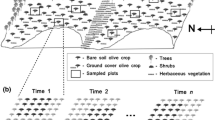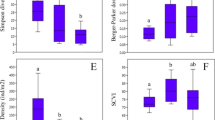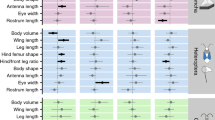Abstract
The structural complexity of habitats has been espoused as an important factor influencing natural-enemy abundance and food-web dynamics in invertebrate-based communities, but a rigorous synthesis of published studies has not heretofore been conducted. We performed a meta-analytical synthesis of the density response of natural enemies (invertebrate predators and parasitoids) to experimental increases and decreases in the structural complexity of their habitats using data from 43 published studies, reporting 62 independent taxa. Studies varied in structural complexity at two spatial scales (habitat and within-plant architecture) and comprised a diverse array of natural-enemy taxa (natural-enemy assemblage at large, the entire spider assemblage, hunting spiders, web-building spiders, mites, hemipterans, coccinellid beetles, carabid beetles, ants, and parasitoids). For all taxa combined, increasing habitat structure resulted in a large and significant increase in natural enemy abundance. Similarly, decreasing habitat structure significantly diminished natural enemy abundance. Separate meta-analyses at two spatial scales (habitat and within-plant architecture) found that increasing habitat complexity resulted in significant increases in abundance. In particular, manipulating levels of detritus at the habitat spatial scale had the strongest effect on natural enemy abundance. In general, most guilds of natural enemies were significantly affected when the structural complexity of the habitat was altered. Seven of nine natural enemy guilds were more abundant under conditions of increased habitat complexity, with hunting spiders and web-building spiders showing the strongest response followed by hemipterans, mites, and parasitoids. Spiders in particular were negatively affected when habitat structure was simplified. The mechanisms underlying the accumulation of natural enemies in complex-structured habitats are poorly known. However, refuge from intraguild predation, more effective prey capture, and access to alternative resources (alternative prey, pollen, or nectar), are possible candidates. Our analysis was unable to confirm that predators aggregate in complex-structured habitats because prey (mostly herbivores) are more abundant there. The results of this meta-analysis support the view that basal resources mediate top-down impacts on herbivores, and provide encouragement that manipulations of habitat complexity can be made in agroecosystems that will enhance the effectiveness of the natural enemy complex for more effective pest suppression.


Similar content being viewed by others
References
Adams DC, Gurevitch J, Rosenberg MS (1997) Resampling tests for meta-analysis of ecological data. Ecology 78:1277–1283
Agrawal AA (1997) Do leaf domatia mediate a plant–mite mutualism? An experimental test of the effects on predators and herbivores. Ecol Entomol 22:371–376
Altieri MA, Letourneau DK (1982) Vegetation management and biological control in agroecosystems. Crop Prot 1:405–430
Altieri MA, Cure JR, Garcia MA (1993) The role and enhancement of parasitic Hymenoptera biodiversity in agroecosystems. In: LaSalle J, Gould J (eds) Hymenoptera and biodiversity. CAB International, London, pp 257–275
Andow D (1991) Vegetational diversity and arthropod population response. Annu Rev Entomol 36:561–586
Andow DA, Risch SJ (1985) Predation in diversified agroecosystems: relations between a coccinellid predator Coleomegilla maculata and its food. J Appl Ecol 22:357–372
Arnqvist G, Wooster D (1995) Meta-analysis: synthesizing research findings in ecology and evolution. Trends Ecol Evol 10:236–240
Barnes RD (1954) The ecological distribution of spiders in non-forest maritime communities at Beaufort, North Carolina. Ecol Monogr 23:315–337
Barth F (ed) (1985) Neurobiology of arachnids. Springer, Berlin Heidelberg New York
Bommarco R, Fagan WF (2002) Influence of crop edges on movement of generalist predators: a diffusion approach. Agric For Entomol 4:21–30
Bultman TL, Uetz GW (1984) Effect of structure and nutritional quality of litter on abundances of litter-dwelling arthropods. Am Midl Nat 111:165–172
Carcamo HA (1995) Effects of tillage on ground beetles (Coleoptera: Carabidae): a farm-scale study in central Alberta. Can Entomol 127:631–639
Clark MS, Gage SH, Spence JR (1997) Habitats and management associated with common ground beetles (Coleoptera: Carabidae) in a Michigan agricultural landscape. Environ Entomol 26:519–527
Cooper H, Hedges LV (1994) The handbook of research synthesis. Russell Sage Foundation, New York
Cromartie Jr WJ (1981) The environmental control of insects using crop diversity. In: CRC handbook of pest management in agriculture, vol 1. CRC Press, Boca Raton, Fla., pp 223–251
Denno RF, Gratton C, Peterson MA, Langellotto GA, Finke DL, Huberty AF (2002) Bottom-up forces mediate natural-enemy impact in a phytophagous insect community. Ecology 83:1443–1458
Döbel HG (1996) Spider–planthopper interactions: influence of predator aggregation, vegetation structure, and temporal refuges on prey suppression. PhD, Department of Entomology, University of Maryland, College Park, Md.
Döbel HG, Denno RF (1994) Predator–planthopper interactions. In: Denno RF, Perfect TJ (eds) Planthoppers: their ecology and management. Chapman and Hall, New York, pp 325–399
Duffey E (1966) Spider ecology and habitat structure. Senckenb Biol 47:45–49
Fagan WF, Hakim AL, Ariawan H, Yuliyantiningsih S (1998) Interactions between biological control efforts and insecticide applications in tropical rice agroecosystems: the potential role of intraguild predation. Biol Control 13:121–126
Finke DL, Denno RF (2002) Intraguild predation diminished in complex-structured vegetation: implications for prey suppression. Ecology 83:643–652
Forkner RE, Hunter MD (2000) What goes up must come down? Nutrient addition and predation pressure on oak herbivores. Ecology 81:1588–1600
Gratton C, Denno RF (2003) Seasonal shift from top-down to bottom-up impact in a phytophagous insect community. Oecologia 134:487–495
Grostal P, O’Dowd DJ (1994) Plants, mites and mutualism: leaf domatia and the abundance and reproduction of mites on Viburnum tinus (Caprifoliaceae). Oecologia 97:308–315
Gunnarsson B (1990) Vegetation structure and the abundance and size distribution of spruce-living spiders. J Anim Ecol 59:743–752
Gurevitch J, Hedges LV (1993) Meta-analysis: combining the results of independent experiments. In: Sceiner SM, Gurevitch J (eds) Design and analysis of ecological experiments. Chapman and Hall, New York, pp 378–398
Gurevitch J, Morrow LV, Wallace A, Walsh JA (1992) A meta-analysis of field experiments on competition. Am Nat 140:539–572
Gurr GM, Wratten SD, Irvin NA, Hossain Z, Baggen LR, Mensah RK, Walker PW (1998) Habitat manipulation in Australia: recent biological control progress and prospects for adoption. Proc Sixth Aust Appl Entomol Res Conf Brisbane 2:225–236
Halaj JD, Wise DH (2002) Impact of a detrital subsidy on trophic cascades in a terrestrial grazing food web. Ecology 83:3141–3151
Hanks LM (1991) Factors influencing the distribution and abundance of the white peach scale, Pseudaulacaspis pentagona (Targioni-Tozzetti) (Homoptera: Diaspididae): host plants and natural enemies. PhD, University of Maryland (Entomology), College Park, Md.
Haussmann A (1996) The effects of weed strip management on pests and beneficial arthropods in winter wheat fields. Z Pflanzenkr Pflanzenpathol Pflanzenschutz 103:70–81
Hedges LV, Olkin I (1985) Statistical methods for meta-analysis. Academic, San Diego
House GJ, All JN (1981) Carabid beetles in soybean agroecosystems. Environ Entomol 10:194–196
Hunter MD, Price PW (1992) Playing chutes and ladders: heterogeneity and diversity at three trophic levels in natural communities. Ecology 73:724–732
Jmhasly P, Nentwig W (1995) Habitat management in winter wheat and evaluation of subsequent spider predation on insect pests. Acta Ecol 16:389–403
Kajak H (1960) Changes in the abundance of spiders in several meadows. Ekol Pol Ser A 8:199–228
Kareiva P, (1987) Habitat fragmentation and the stability of predator–prey interactions. Nature 326:388–391
Kareiva P, Sahakian R (1990) Tritrophic effects of a simple architectural mutation in pea plants. Nature 345:433–434
Kenmore PE, Cariño FO, Perez CA, Dyck VA, Gutierrez AP (1984) Population regulation of the rice brown planthopper (Nilaparvata lugens) within rice fields in the Philippines. J Plant Prot Tropics 1:19–37
Landis DA, Wratten SD, Gurr GM (2000) Habitat management to conserve natural enemies of arthropod pests in agriculture. Annu Rev Entomol 45:175–201
Langellotto GA (2002) Aggregation of invertebrate predators in complex structured habitats: role of altered cannibalism, intraguild predation, prey availability, and microclimate. PhD, University of Maryland (Entomology), College Park, Md.
Leddy PM (1996) Factors influencing the distribution and abundance of azalea lacebug, Stephanitis pyrioides, in simple and complex landscape habitats. PhD, University of Maryland (Entomology), College Park, Md.
Lowrie DC (1948) The ecological succession of spiders of the Chicago area dunes. Ecology 29:334–351
Luczak J (1963) Differences in the structure of communities of web spiders in one type of environment (young pine forest). Ekol Pol Ser A 11:160–221
Lys JA, Zimmermann M, Nentwig W (1994) Increase in activity density and species number of carabid beetles in cereals as a result of strip-management. Entomol Exp Appl 73:1–9
Marino PC, Landis DA (1996) Effect of landscape structure on parasitoid diversity and parasitism in agroecosystems. Ecol Appl 61:276–284
McCoy ED, Bell SS (1991) Habitat structure: the evolution and diversification of a complex topic. In: Bell SS, McCoy ED, Mushinsky HR (eds) Habitat structure: the physical arrangements of objects in space. Chapman and Hall, London, pp 3–27
McNett BJ, Rypstra AL (2000) Habitat selection in a large orb-weaving spider: vegetation complexity determines site selection and distribution. Ecol Entomol 25:423–432
Menalled FB, Marino PC, Gage SH, Landis DA (1999) Does agricultural landscape structure affect parasitism and parasitoid diversity? Ecol Appl 9:634–641
Norton AP, Belden E, English-Loeb G (2001) Host plant manipulation of natural enemies: leaf domatia protect beneficial mites from insect predators. Oecologia 126:535–542
Nyrop J, English-Loeb G, Roda A (1998) Conservation biological control of spider mites in perennial cropping system. In: Barbosa P (ed) Conservation biological control. Academic, San Diego, Calif., pp 307–333
Patt JM, Hamilton GC, Lashomb JH (1997) Impact of strip-insectary intercropping with flowers on conservation biological control of the Colorado potato beetle. Adv Hortic Sci 11:175–181
Perfecto I, Sediles A (1992) Vegetational diversity, ants (Hymenoptera: Formicidae), and herbivorous pests in a neotropical agroecosystem. Environ Entomol 21:61–67
Polis GA (1999) Why are parts of the world green? Multiple factors control productivity and the distribution of biomass. Oikos 86:3–15
Polis GA, Strong DR (1996) Food web complexity and community dynamics. Am Nat 147:813–846
Polis GA, Myers CA, Holt RD (1989) The ecology and evolution of intraguild predation: potential competitors that eat each other. Annu Rev Ecol Syst 20:297–330
Polis GA, Anderson WB, Holt RD (1997) Toward an integration of landscape and food web ecology: the dynamics of spatially subsidized food webs. Annu Rev Ecol Syst 28:289–316
Price PW, Bouton CE, Gross P, McPheron BA, Thompson JN, Weis AE (1980) Interactions among three trophic levels: influence of plants on interactions between insect herbivores and natural enemies. Annu Rev Ecol Syst 11:41–65
Riechert SE, Bishop L (1990) Prey control by an assemblage of generalist predators: spiders in garden test systems. Ecology 71:1441–1450
Roda A, Nyrop J, Dicke M, English-Loeb G (2000). Trichomes and spider-mite webbing protect predatory mite eggs from intraguild predation. Oecologia 125:428–435
Rosenberg MS, Adams DC, Gurevitch J (2000) MetaWin: statistical software for meta-analysis with resampling tests, ver. 2.0. Sinauer, Sunderland, Mass.
Rosenheim JA (2001) Source-sink dynamics for a generalist insect predator in habitats with strong higher-order predation. Ecol Monogr 71:93–116
Rosenheim JA, Wilhoit LR, Armer CA (1993) Influence of intraguild predation among generalist insect predators on the suppression of an herbivore population. Oecologia 96:439–449
Rosenthal R (1979) The “file drawer problem” and tolerance for null results. Psychol Bull 86:638–641
Rypstra AL, Carter PE, Balfour RA, Marshall SD (1999) Architectural features of agricultural habitats and their impact on the spider inhabitants. J Arachnol 27:371–377
Schmitz OJ, Hambäck PA, Beckerman AP (2000) Trophic cascades in terrestrial systems: a review of the effects of carnivore removals on plants. Am Nat 155:141–153
Sheehan W (1986) Response by specialist and generalist natural enemies to agroecosystem diversification: a selective review. Environ Entomol 15:456–461
Siemann E (1998) Experimental tests of effects of plant productivity and diversity on grassland arthropod diversity. Ecology 79:2057–2070
Sunderland K, Samu F (2000) Effects of agricultural diversification on the abundance, distribution, and pest control potential of spiders: a review. Entomol Exp Appl 95:1–13
Symondson WOC, Sunderland KD, Greenstone MH (2002) Can generalist predators be effective biocontrol agents? Annu Rev Entomol 47:561–594
Thies C, Tscharntke T (1999) Landscape structure and biological control in agroecosystems. Science 285:893–895
Thomas MB, Wratten SD, Sotherton NW (1991) Creation of ‘island’ habitats in farmland to manipulate populations of beneficial arthropods: predator densities and emigration. J Appl Ecol 28:906–917
Tonhasca A Jr, Byrne DN (1994) The effects of crop diversification on herbivorous insects: a meta-analytical approach. Ecol Entomol 19:239–244
Tooker JF, Hanks LM (2000) Influence of plant community structure on natural enemies of pine needle scale (Homoptera: Diaspididae) in urban landscapes. Environ Entomol 26:1305–1311
Uetz GW (1991) Habitat structure and spider foraging. In Bell SS, McCoy ED, Mushinsky HR (eds) Habitat structure: the physical arrangements of objects in space. Chapman and Hall, London, pp 325–348
Uetz GW, Stratton GE (1982) Acoustic communication and reproductive isolation in spiders. In: Witt PN, Rovner JS (eds) Spider communication: mechanisms and ecological significance. Princeton University Press, Princeton, pp 123–159
Van Zandt PA, Mopper S (1998) A meta-analysis of adaptive deme formation in phytophagous insect populations. Am Nat 10:183–199
Wagner JD, Wise DH (1996) Cannibalism regulates densities of young wolf spiders: evidence from field and laboratory experiments. Ecology 77:639–652
Watt AD, Stork NE, McBeath C, Lawson GL (1997) Impact of forest management on insect abundance and damage in a lowland tropical forest in southern Cameroon. J Appl Ecol 34:985–998
Wetzler RE, Risch SJ (1984) Experimental studies of beetle diffusion in simple and complex crop habitats. J Anim Ecol 53:1–19
White AJ, Wratten SD, Berry NA, Weigmann U (1995) Habitat manipulation to enhance biological control of Brassica pests by hover flies (Diptera: Syrphidae). J Econ Entomol 88:1171–1176
Wise DH, Chen B (1999) Impact of intraguild predators on survival of a forest-floor wolf spider. Oecologia 121:129–137
Zangger AJ, Lys A, Nentwig W (1994) Increasing the availability of food and the reproduction of Poecilus cupreus in a cereal field by strip-management. Entomol Exp Appl 71:111–120
Acknowledgements
Jaraj Halaj, Ronald Hammond, Deborah Letourneau, and Ann Rypstra graciously shared experimental means, variance estimates, and sample sizes for inclusion in this meta-analysis. We thank Pedro Barbosa, Mary Christman, Galen Dively, Irv Forseth, Larry Hanks, Jason Harmon, Andrea Huberty, Charles Mitter, Russel Monson, Jay Rosenheim, Ann Rypstra and one anonymous reviewer for comments and suggestions that improved this manuscript. This work was supported in part by the Arthur C. Gahan fellowship from the Department of Entomology, University of Maryland to G.A.L., and National Science Foundation Grants DEB-9527846 and DEB-9903601 to R.F.D.
Author information
Authors and Affiliations
Corresponding author
Electronic Supplementary Material
Rights and permissions
About this article
Cite this article
Langellotto, G.A., Denno, R.F. Responses of invertebrate natural enemies to complex-structured habitats: a meta-analytical synthesis. Oecologia 139, 1–10 (2004). https://doi.org/10.1007/s00442-004-1497-3
Received:
Accepted:
Published:
Issue Date:
DOI: https://doi.org/10.1007/s00442-004-1497-3




